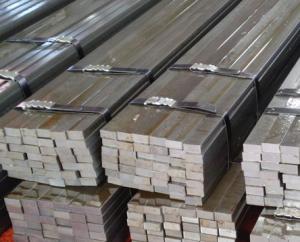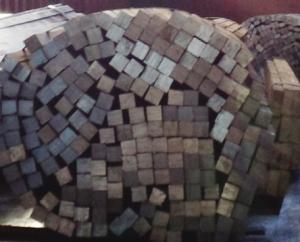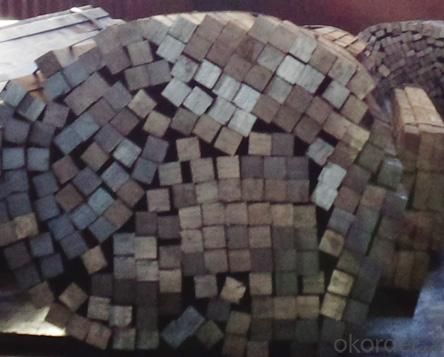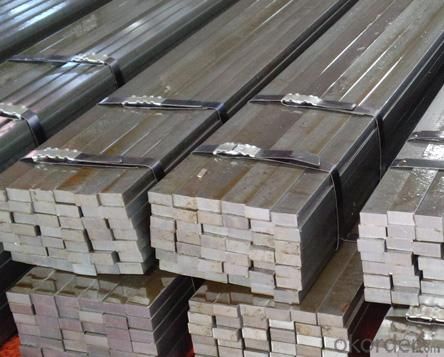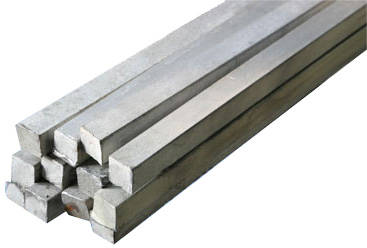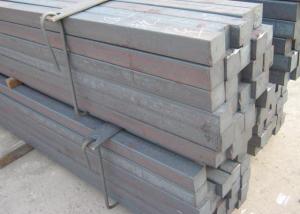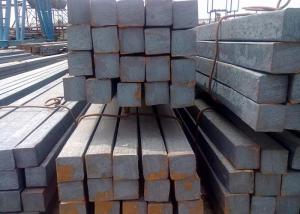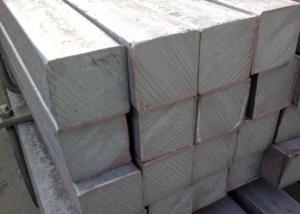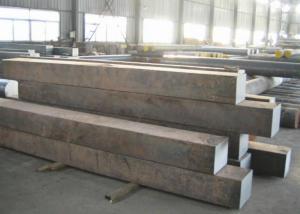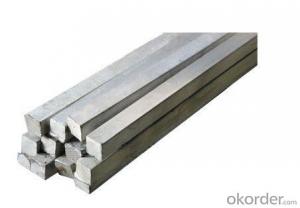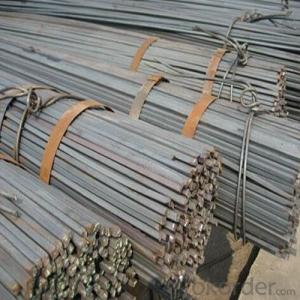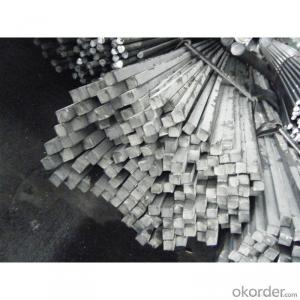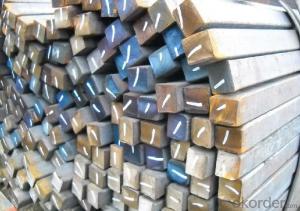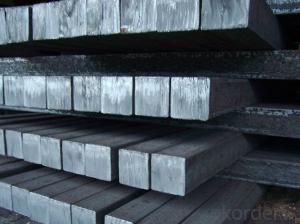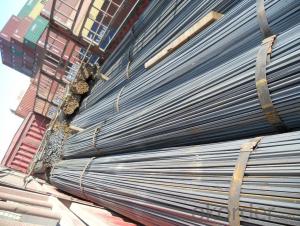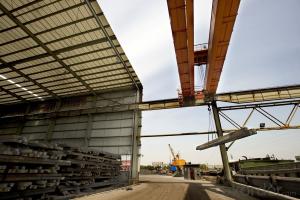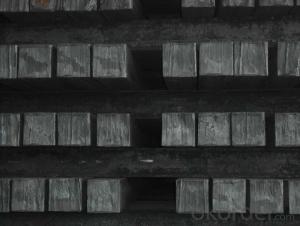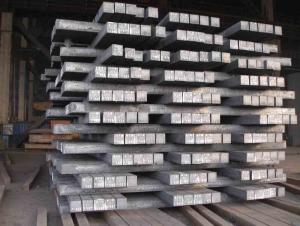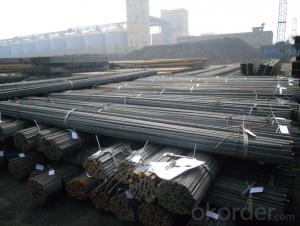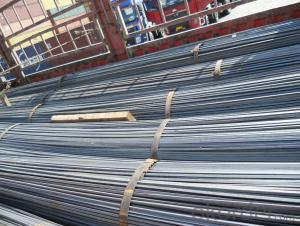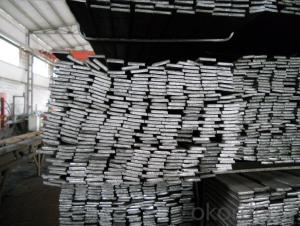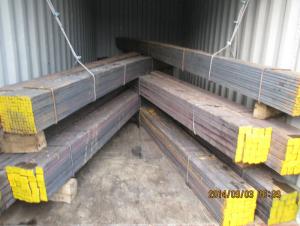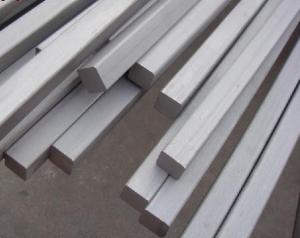Hot Rolled Stainless Steel Square Bar
- Loading Port:
- China Main Port
- Payment Terms:
- TT or LC
- Min Order Qty:
- -
- Supply Capability:
- 1000 tons per month m.t./month
OKorder Service Pledge
Quality Product, Order Online Tracking, Timely Delivery
OKorder Financial Service
Credit Rating, Credit Services, Credit Purchasing
You Might Also Like
the Hot Rolled Stainless Steel Square Bar is hot rolled, range from 5mm to 100mm,
Grade: Q195 Q235 and equivalent.
the monthly production capacity can be 500-1000 tons
it is used as structure steel.
the MOQ is usually 50 tons
canbe delivered by bulk vessel or by container.
- Q: How do you use a steel square to measure and mark beveled angles?
- To use a steel square to measure and mark beveled angles, you need to follow a few simple steps. First, make sure your steel square is clean and free of any debris or rust. This will ensure accurate measurements and markings. Next, identify the angle you want to measure and mark. Let's say you want to mark a 45-degree beveled angle. Place the long edge of the steel square against the edge of the material you want to mark. In this case, it would be the edge where you want the beveled angle to start. Now, rotate the steel square until the 45-degree line aligns with the edge of the material. You can find the 45-degree line on the inside of the square, usually marked with a number or a symbol. Once the 45-degree line is aligned, hold the steel square firmly against the material and use a pencil or a scribe to mark the line along the other edge of the square. You have now successfully measured and marked a 45-degree beveled angle using a steel square. Remember, the process may vary depending on the angle you want to measure and mark. Some steel squares may have additional lines or markings to help you with specific angles. It's always a good idea to refer to the manufacturer's instructions or guides if you're unsure about a particular angle.
- Q: Can a steel square be used for checking the squareness of a foundation?
- Yes, a steel square can be used for checking the squareness of a foundation. A steel square is a versatile tool that can be used to measure right angles accurately. By placing the steel square against the foundation's corners, one can determine if the foundation is square or not based on the alignment of the edges.
- Q: How do you use a steel square for creating precise corner spline joints?
- To use a steel square for creating precise corner spline joints, you would first measure and mark the desired location for the joint on the wood. Next, place the steel square on the marked corner and align it with the adjacent edges of the wood. Use a pencil or a knife to trace along the edge of the square, creating a precise guideline for the joint. Repeat this process on the other piece of wood that will be joined. This guideline will help you accurately cut and align the splines, ensuring a precise and snug fit for the joint.
- Q: How do you use a steel square to measure outside corners?
- To use a steel square to measure outside corners, follow these steps: 1. Begin by placing the steel square against one side of the corner, aligning the long edge of the square with the edge of the corner. 2. Hold the steel square firmly, ensuring that it is flush against the corner. 3. Take note of the measurement on the outer edge of the square where it aligns with the other side of the corner. This measurement represents the length of the outside corner. 4. If you need to transfer this measurement to another material or surface, use a pencil or marker to mark the length on the desired location. By using a steel square, you can accurately measure the length of outside corners, ensuring precise measurements for various construction or woodworking projects.
- Q: How do you use a steel square to find angles for coping cuts?
- To determine angles for coping cuts, there are several steps you should follow: 1. Begin by identifying the specific angle you need to cut, whether it is a corner angle or a miter joint angle. 2. Position the steel square on the workpiece, ensuring that one side of the square is aligned with the material's edge. 3. Rotate the square until the opposite side is aligned with the adjacent edge or surface. This will create a corner where the two material edges meet. 4. Once the square is aligned correctly, use a pencil or scribe to mark the angle on the workpiece by drawing along the square's edge. 5. Remove the square from the workpiece and extend the marked line as necessary. 6. Finally, execute the coping cut along the marked line using the appropriate tool, such as a coping saw or jigsaw. By utilizing a steel square to determine angles for coping cuts, you can accurately transfer the angle from one material piece to another, ensuring a precise fit for your project. It is crucial to verify your measurements and make any required adjustments prior to making the final cut.
- Q: What are some common techniques for using a steel square in carpentry?
- The steel square, widely employed in carpentry, is a versatile tool utilized for measuring, marking, and laying out angles. Below are several standard methods for employing a steel square in carpentry: 1. Squareness examination: One primary function of a steel square is to determine if a corner or joint is perfectly square. Position the square against the corner and assess whether both edges align with the adjacent surfaces. If they do, the corner is square. 2. Angle determination: Steel squares are ideal for measuring and marking angles in carpentry. The square typically features degree markings along its blade, enabling accurate angle measurement. For instance, if a 45-degree angle cut is required on a piece of wood, the square can be used to mark the angle and guide the saw. 3. Measurement transfer: Steel squares can be employed to transfer measurements from one surface to another. For example, if a line parallel to an existing edge needs to be marked, the square can be placed against the edge, and a line can be drawn along the blade of the square. 4. Perpendicular line creation: The 90-degree angle of the steel square is perfect for generating perpendicular lines. By aligning the square against an edge, a line perpendicular to that edge can be easily drawn. 5. Rafter length determination: When constructing roofs, carpenters often utilize steel squares to calculate rafter lengths. By employing the square's various measurements and formulas, the required length and angles for rafters can be determined. 6. Miter cut setup: Steel squares are invaluable for setting up miter cuts in trim work. By utilizing the square's angle markings, precise measurements and markings for desired angles can be made, ensuring accurate cuts. 7. Level and plumb verification: Steel squares can also be employed to check if something is level or plumb. By placing the square against a vertical or horizontal surface, it can be determined if it is perfectly vertical or horizontal. These are merely a few of the many techniques frequently employed with a steel square in carpentry. With its versatility and precision, the steel square is an essential tool for any carpenter.
- Q: What are the different techniques for using a steel square in metalworking projects?
- There are several techniques for using a steel square in metalworking projects. Here are a few commonly used techniques: 1. Measuring and marking: One of the primary uses of a steel square is for measuring and marking precise angles and lengths on metal. By placing the square against the edge of the metal and aligning it with the desired angle or length, you can make accurate measurements and mark the metal accordingly. 2. Checking squareness: Steel squares are also used to check the squareness or perpendicularity of metal components. By placing the square against the edges or corners of the metal, you can determine if they are perfectly square or if any adjustments need to be made. 3. Setting up tools and machinery: Steel squares can be used to set up tools and machinery in metalworking projects. By aligning the square with the tool or machine's components, you can ensure that they are positioned correctly and at the desired angles. 4. Creating right angles: Steel squares are ideal for creating right angles in metal. By placing the square against the edge of the metal and using it as a guide, you can make precise cuts or bends to create perpendicular edges. 5. Checking flatness: Steel squares can be used to check the flatness of metal surfaces. By placing the square on different areas of the metal and observing any gaps or inconsistencies, you can determine if the surface is flat or if it needs further work. 6. Transferring measurements: Steel squares can also be used to transfer measurements from one piece of metal to another. By aligning the square with the measurement on the first piece and then marking the same measurement on the second piece, you can ensure accuracy in your metalworking projects. Overall, a steel square is a versatile tool in metalworking projects, enabling precise measurements, checking angles, ensuring squareness, and assisting in various other tasks.
- Q: How do you use a steel square to determine roof valley angles?
- To determine roof valley angles using a steel square, you would place the square at the valley on the roof and align one edge with the roof slope. Then, you can read the angle measurement on the square to determine the valley angle.
- Q: How do you use a steel square for marking and cutting tenons?
- To use a steel square for marking and cutting tenons, follow these steps: 1. Start by ensuring that the steel square is clean and free of any rust or debris. This will ensure accurate measurements and markings. 2. Measure the width of the tenon required on the workpiece. For example, if you need a tenon that is 1 inch wide, align the edge of the steel square with the end of the workpiece and mark a line at the 1-inch mark on the square. 3. Next, determine the depth of the tenon. For instance, if you need a tenon that is 2 inches deep, align the square's tongue (the shorter part of the "L" shape) with the edge of the workpiece and mark a line at the 2-inch mark on the square. 4. Use a straight edge, such as a ruler or a level, to connect the lines you marked in steps 2 and 3. This will give you a clear visual representation of the tenon's size and location on the workpiece. 5. Once the tenon is marked, use a saw to carefully cut along the lines you made. Take your time and ensure a clean and accurate cut. 6. After cutting the tenon, you may need to use a chisel or a rasp to refine the edges and make any necessary adjustments for a perfect fit. Remember, practice and precision are key when using a steel square for marking and cutting tenons. Measure accurately, make clean cuts, and take your time to ensure a professional result.
- Q: Can a steel square be used for checking the alignment of a wall frame?
- Indeed, one can utilize a steel square to assess the alignment of a wall frame. Commonly referred to as a framing square, a steel square is a versatile tool extensively employed in carpentry and construction. Comprised of a lengthy blade and a shorter tongue that intersect at a right angle, it assumes the shape of an L. Its purpose is specifically tailored to facilitate the measurement and marking of right angles, as well as to inspect the alignment of various building components. Concerning the evaluation of a wall frame's alignment, a steel square serves multiple functions. Firstly, it guarantees the perfect squareness of the frame's corners. Carpenters can ascertain the precision of the 90-degree corners by placing the square's blade and tongue against the frame's edges. This step is crucial in maintaining the frame's structural integrity and ensuring its proper alignment. Furthermore, a steel square can be employed to verify the straightness and alignment of the frame's studs or joists. By positioning the square against the surface of the studs, carpenters can conveniently discern any deviations from the desired alignment. This enables them to make necessary adjustments before proceeding with further construction activities. Ultimately, a steel square stands as an indispensable tool for evaluating the alignment of a wall frame. Its capacity to measure and mark right angles, validate square corners, and identify misalignments in studs or joists renders it an essential instrument within the construction industry.
STEXIN, an enterprise specializing in the production and sales of square bar, round bar and flat bar. The annual production capacity of square billet is 60,000 mtons, and sturtual steel 80,000 mtons.
1. Manufacturer Overview
| Location | Renqiu, China |
| Year Established | 1996 |
| Annual Output Value | Above US$ 30 Million |
| Main Markets | Mid East; Southeast Aisa |
| Company Certifications |
2. Manufacturer Certificates
| a) Certification Name | |
| Range | |
| Reference | |
| Validity Period |
3. Manufacturer Capability
| a) Trade Capacity | |
| Nearest Port | Tianjin; |
| Export Percentage | 20% - 30% |
| No.of Employees in Trade Department | 11-20 People |
| Language Spoken: | English; Chinese |
| b) Factory Information | |
| Factory Size: | Above 70,000 square meters |
| No. of Production Lines | 1 |
| Contract Manufacturing | OEM Service Offered |
| Product Price Range | Average |
Send your message to us
Hot Rolled Stainless Steel Square Bar
- Loading Port:
- China Main Port
- Payment Terms:
- TT or LC
- Min Order Qty:
- -
- Supply Capability:
- 1000 tons per month m.t./month
OKorder Service Pledge
Quality Product, Order Online Tracking, Timely Delivery
OKorder Financial Service
Credit Rating, Credit Services, Credit Purchasing
Similar products
Hot products
Hot Searches
Related keywords
